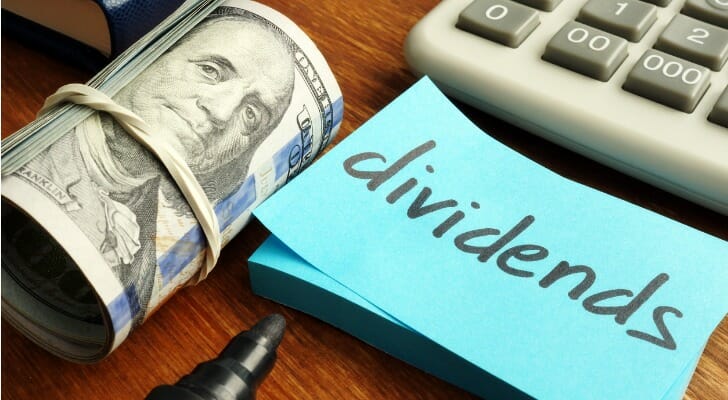The dividend payout ratio can be a helpful metric for comparing dividend stocks. This ratio represents the amount of net income that a company pays out to shareholders in the form of dividends. The dividend payout ratio, or DPR, doesn’t necessarily tell you how financially healthy a company is, but it can tell you how a company spends the revenue it generates. Investing in dividend stocks could make sense if you’re interested in generating passive income or reinvesting dividends to build wealth. Understanding what the dividend payout ratio means and how it’s calculated is something to keep in mind as you choose dividend stocks to invest in.
A financial advisor can help you find the dividend stocks that are the best fit for your goals, timeline and risk profile.
Dividend Payout Ratio, Definition
A dividend represents a percentage of profits that are paid out to company shareholders. In a sense, a dividend is a financial reward you can get simply for investing in a particular company.
Dividend payouts can vary from company to company. Some companies pay out all of their profits to shareholders as dividends. Others only pay out some of their profits as dividends.
A dividend payout ratio reflects the total amount of dividends a company pays to its shareholders in relation to its net income. At a glance, the dividend payout ratio tells you what percentage of net income shareholders receive in the form of dividend payments.
In terms of what dividend payout ratio means for investors, DPR can tell you what a company pays out to shareholders and what it keeps from net income. Funds that aren’t used for dividend payouts can be used to pay off debt or invest in growth and expansion projects. Companies may also allocate some of these funds to cash reserves.
How to Calculate Dividend Payout Ratio
If you’re interested in calculating a company’s DPR, it’s relatively easy to do using information that’s found on the company’s income statement and balance sheet. The simplest way to calculate the dividend payout ratio requires you to know the total dividends paid and the company’s net income. In this calculation, the dividend payout ratio is equal to total dividends divided by net income. For example, if a company’s total dividend payouts come to $10 million and net income is $100 million then the dividend payout ratio would equal 10%. In other words, the company pays out 10% of net income to shareholders as dividends and keeps the remaining 90%.
You can also calculate the dividend payout ratio using earnings per share (EPS). Earnings per share is calculated as the company’s profit divided by the total number of outstanding shares of stock. To calculate DPR using earnings per share, you’d divide the dividends per share by EPS.
A third way to calculate the dividend payout ratio uses the retention ratio. This ratio is a measure of the percentage of net income a company keeps as retained earnings. To find DPR using this method, you’d first find the retention ratio. You can do this by subtracting dividends per share from earnings per share, then dividing by earnings per share. You’d then subtract this number from 1 to get the dividend payout ratio.
Dividend Payout Ratio vs. Dividend Yield
The dividend yield is another way to measure how much of income a company pays out to investors. Specifically, dividend yield reflects the annual dividend per share divided by the stock’s share price.
At first glance, a higher dividend yield may seem like a good thing as it indicates that a company is paying out more of its profits in dividends. But it’s important to consider whether a high dividend yield is sustainable, relative to how much of its earnings a company is paying out.
Again, some companies may pay out 100% of earnings in dividends. But it’s possible for companies to pay out more than 100% of earnings as dividends. In the short term, that might not be a problem. But over the longer term, the company may not be able to continue paying out such a high yield to investors. The end result can be a reduction in dividend payouts.
For that reason, it’s important to consider the dividend payout ratio as well as the dividend yield. Looking at the numbers side by side can help paint a clearer picture of how much you can realistically expect from a company where dividend payouts are concerned.
How to Use Dividend Payout Ratio to Invest
You may be wondering what DPR means and why you should know how to calculate it when investing in dividend stocks. Along with other dividend metrics, such as dividend yield, DPR can help you decide which dividend stocks you want to invest in. For example, a company that has a higher dividend payout ratio is paying out more of its net income to investors and putting less money into the business or paying off debt. The Dividend Aristocrats, for example, represent companies that have consistently increased dividend payouts for 25 consecutive years or more. You may choose to invest in one of these companies if you’re looking for reliable dividend income.
On the other hand, a company that has a lower dividend payout ratio may be more focused on paying off debt or growing the business. That might mean a smaller dividend payout to investors in the near term but you could benefit from capital appreciation later if growth efforts increase the company’s value and share price.
Whether it makes sense for you to choose a company that has a higher or lower DPR can depend on your goals and objectives. If you’re more interested in generating passive income then you might lean toward companies that pay out more of their dividends to shareholders. On the other hand, if you’re looking for long-term growth then a company with a lower dividend payout ratio could be a good fit.
One thing to keep in mind is that dividend payout ratios can vary greatly from company to company. There can be significant differences in dividend payouts based on the age and size of different companies and the industries they belong to. So if you’re using DPR to evaluate multiple companies, it’s important to keep that in mind as you may not always be able to make apples-to-apples comparisons.
The Bottom Line
Calculating the dividend payout ratio can make it easier to understand how much of a company’s net income it pays back to investors. It’s important to remember that there’s no such thing as a “good” or “bad” DPR; each ratio is unique to the company. Using the dividend payout ratio along with dividend yield and other dividend metrics can help when deciding where to invest.
Tips for Investing
- If you’re investing for dividends, consider what you plan to do with them. Again, you can use dividends for current income. That’s something you might be interested in if you’re nearing retirement or already retired. You can also reinvest dividends if you don’t need them for income right now. Many dividend stocks offer a dividend reinvestment plan or DRIP that allows you to use yur dividends to buy additional shares. This can be a simple way to leverage your dividends for fractional share investing to grow your portfolio.
- Consider talking to a financial advisor about the best way to use dividend stocks in your investment plan. If you don’t have a financial advisor yet, finding one doesn’t have to be complicated. SmartAsset’s financial advisor matching tool makes it easy to connect with professional advisors in your local area. It takes just a few minutes to get your personalized advisor recommendations online. If you’re ready, get started now.
- Besides dividend stocks, you should consider diversifying your portfolio with things like mutual funds, bonds and exchange-traded funds (ETFs). To get a sense of how your investments should be divided up, use SmartAsset’s asset allocation calculator.
Photo credit: ©iStock.com/designer491, ©iStock.com/Olivier Le Moal, ©iStock.com/golero


